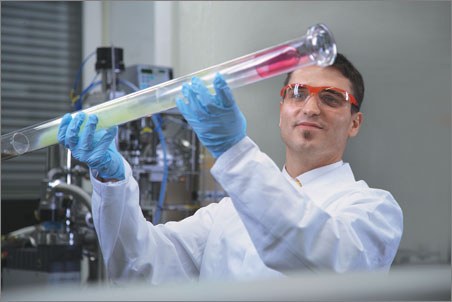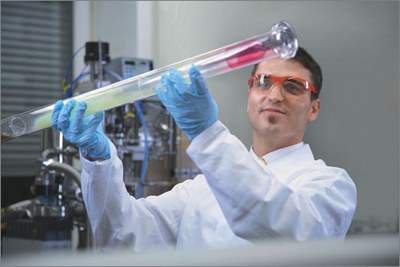BASF and OSRAM Set New Standards for OLEDs: 60 lm/W and White Color Requirements Met
BASF and OSRAM Opto Semiconductors have developed a highly efficient white organic light-emitting diode (OLED): for the first time an OLED not only is able to achieve a light yield of over 60 lumens per watt (lm/W), but also, at the same time, meets the international Energy Star SSL Standard with regard to color requirements.
Lighting efficiency on this scale had been achieved previously. Lighting efficiency describes the ratio of luminous flux given off by a lamp to the amount of power consumed; the greater the yield, the less energy is lost. However, up until now the color values of OLEDs have not been within the acceptable band for color coordinates around the Planck curve, as defined by the Energy Star SSL Standard. The color values of the new OLED are within this band – its light retains the white color at different levels of intensity.
By developing a white OLED with a high light yield, the two companies have completed a major step on the way towards commercial OLED lighting. In the development laboratories of Siemens Corporate Technology (OSRAM is part of the Industry sector of Siemens) highly efficient semiconductor materials from BASF Research were combined with standard materials – and thereby new standards set with regard to color coordinates and efficiency. BASF and OSRAM are conducting research together within the framework of the “OLEDs for Applications on the Lighting Market” (OPAL) project. The OPAL project is being sponsored as part of the OLED Initiative of the German Federal Ministry for Education and Research (BMBF).
The new OLEDs contain phosphorescent metal complexes as emitter materials and customized complementary materials, which ensure optimum constancy of the color temperatures. That means that, owing to the use of new materials, the diodes are very color-stable even when there are variations in luminous intensity. The challenge now is to optimize the life of these OLED tiles, especially by stabilizing the blue emitters.
The Lighting Solution of the Future:
However, OLEDs offer even more convincing advantages. Unlike conventional filament bulbs they do not become hot when emitting light and less energy is lost through radiated heat. The laboratory results show that the new OLEDs are five times as efficient as filament bulbs and up to 50 percent more efficient compared with standard low-energy lamps. OLEDs consume much less electricity than conventional sources of light, so consumers will in future be able to cut their electricity costs with OLEDs.
The experts at BASF are dealing with the material side of the OLEDs and, within the framework of the OPAL project, are developing the optimum component structures in partnership with Philips and OSRAM. BASF reached an important milestone in OLED research a few years ago. White light from OLEDs can best be obtained by combining red, green and blue light. For a long time there was no efficient source for deep-blue light. In 2003 BASF researchers laid the foundation for a phosphorescent blue emitter by developing a new class of materials based on an iridium complex. “Our aim is to develop stable blue phosphorescence emitters. Whilst the color coordinates and efficiencies of the new blue OLEDs are already outstanding, the service life still presents many challenges,” explains Dr. Elmar Keßenich, OLED project manager at BASF Future Business GmbH. “If we manage to produce deep-blue stable emitters, that will open up the way for us to make white OLED light tiles with a light yield of more than 100 lm/W.”
In future, organic light-emitting diodes will be suitable for general lighting as flat sources of light – for offices or as decorative lighting in stores. And they not only offer the potential of being considerably more economical than conventional low-energy bulbs in terms of electricity consumption, but are also capable of being used in a variety of ways as flat, transparent and, in future also, flexible sources of light. They will provide completely new opportunities in terms of design and performance − in part owing to newly developed semiconductor materials from BASF. “The challenge now lies with the process engineers to apply these high efficiencies economically to large active areas,” says Dr. Karsten Heuser, OPAL Coordinator and Director OLED Lighting Technology at OSRAM Opto Semiconductors.
About BASF:
BASF is the world’s leading chemical company: The Chemical Company. Its portfolio ranges from chemicals, plastics, performance products, agricultural products and fine chemicals to crude oil and natural gas. As a reliable partner to virtually all industries, BASF’s high-value products and intelligent system solutions help its customers to be more successful. BASF develops new technologies and uses them to meet the challenges of the future and open up additional market opportunities. It combines economic success with environmental protection and social responsibility, thus contributing to a better future. BASF has approximately 95,000 employees and posted sales of €52.6 billion in 2006. BASF shares are traded on the stock exchanges in Frankfurt (BAS), London (BFA), New York (BF) and Zurich (AN). Further information on BASF is available on the Internet at http://www.basf.com/.
About BASF Future Business GmbH:
BASF Future Business GmbH, a 100 percent subsidiary of BASF SE, was founded in April 2001. It aims to open up business areas with above-average growth rates that lie outside BASF's mainstream activities. The company focuses on chemistry-based new materials, technologies and system solutions. BASF Future Business GmbH commissions research from BASF’s R&D units but also cooperates with startup companies, industrial partners, universities and potential customers. Other alternatives include the acquisition of direct stakes, joint ventures with partner companies or provision of venture capital via the subsidiary BASF Venture Capital GmbH.Further information on BASF Future Business is available on the Internet at http://www.basf-fb.de/.
About OSRAM Opto Semiconductors:
OSRAM is part of the Industry sector of Siemens and one of the two leading lighting manufacturers in the world. Its subsidiary OSRAM Opto Semiconductors GmbH in Regensburg (Germany) offers its customers solutions based on semiconductor technology for the lighting, sensor and visualization sectors. OSRAM Opto Semiconductors has production sites in Regensburg (Germany) and Penang (Malaysia). Its headquarters for North America is in Santa Clara (USA) and for Asia in Hong Kong. OSRAM Opto Semiconductors also has sales offices throughout the world. In the 2007 fiscal year (to the end of September) OSRAM Opto Semiconductors employed more than 4000 people and achieved sales totaling 520 million euros. For more information go to http://www.osram-os.com/.


